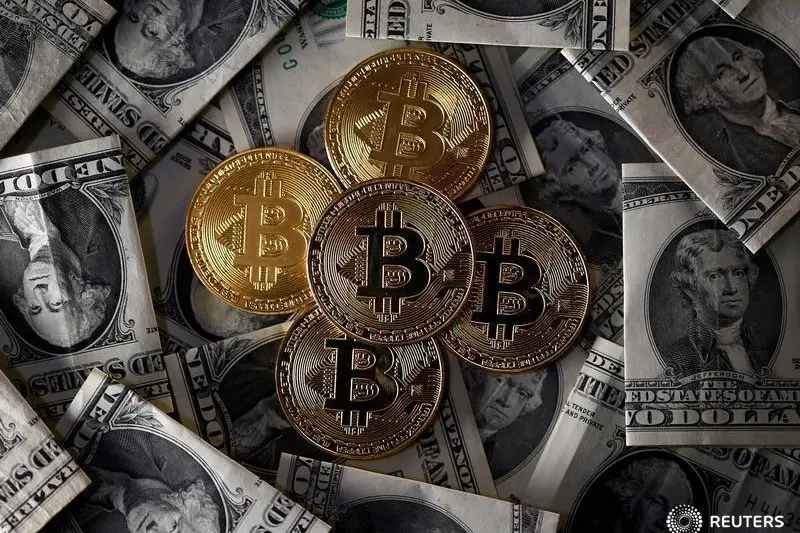PHOTO
NEW YORK- Crypto-currencies are poised to take the mainstream center stage. Fortress Investment alumnus Mike Novogratz is launching a hedge fund, exchanges like CME are teeing up bitcoin futures, big banks are likely to enter the fray, and even the Federal Reserve is taking notice. It may well end in tears, but Wall Street won’t pass up a $300 billion market. There is no shortage of doubters. JPMorgan boss Jamie Dimon famously called bitcoin a “fraud” that was “worse than tulip bulbs,” and that was in September when a single coin fetched less than $4,200. Two months later Citadel founder and Chief Executive Ken Griffin pronounced it a bubble just before the digital currency's value surged above $10,000 on Nov. 29 – a 10-fold increase since the start of the year.
Far from inducing caution, the warnings – along with a couple of violent bitcoin price swings – have spread news of the vertiginous trajectory. The number of user accounts at Coinbase, a provider of so-called digital wallets for crypto-currency investors, has jumped more than 2.5 times over the 12 months to Nov. 29, to 13.1 million. Bitcoin trading volume, which rarely exceeded $200 million a day at the start of the year, approached $12 billion on Nov. 30, according to Coinmarketcap.com. Ether, ripple and more than 1,000 other digital currencies together generate a similar amount.
With the outstanding value of bitcoin roughly $180 billion and the total for all crypto-currencies approaching double that figure, financial firms can no longer ignore the phenomenon. Although dozens of small hedge funds invest in crypto-currencies and what are known as initial coin offerings, Novogratz’s imprimatur may lure mainstream investors. The former Fortress macro hedge-fund manager aims to raise $500 million for his fund. Coinbase is launching a custody service to hold digital assets for big institutions.
The CME – once Chicago's hub for trading physical metals – will launch the first U.S. bitcoin futures contract on Dec. 18, with crosstown rival CBOE and Nasdaq planning to follow suit. That may hasten the arrival of mass-market vehicles. The lack of derivatives was one reason the Securities and Exchange Commission rejected a proposed bitcoin exchange-traded fund in March.
Investor demand will surely bring big banks off the sidelines. Even JPMorgan is considering letting its brokerage clients access bitcoin futures, according to the Wall Street Journal. All this says more about speculation and trading volume than long-term value. To a skeptic, it looks like a mania that will eventually break. Until then, though, there’s money to be made.
CONTEXT NEWS
- CME on Dec. 1 said it would launch the first U.S. futures contract on bitcoin on Dec. 18. The contract will be settled in cash based on the exchange’s daily Bitcoin Reference Rate. The margin requirement will be 35 percent and the exchange will set a daily price fluctuation limit of plus or minus 20 percent.
- The Federal Reserve is in early stages of considering “what it would mean” to offer digital currencies sometime in the future and whether it may be necessary as an alternative to cash, William Dudley, president of the Federal Reserve Bank of New York, said on Nov. 29. The following day Randal Quarles, the Fed’s vice chair for supervision, said digital currencies could pose financial stability risks and central banks should proceed cautiously in issuing their own.
- The price of bitcoin, the biggest crypto-currency, surged above $10,000 for the first time on Nov. 29 according to Coindesk, taking the outstanding value of the digital coins over $180 billion.
- Website Coinmarketcap.com tracks over 1,000 digital coins and tokens with a total circulating value over $300 billion as of Dec. 1. Bitcoin and ether are the largest.
(Reporting by Tom Buerkle; Editing by Richard Beales and Kate Duguid)
© Reuters News 2017
Far from inducing caution, the warnings – along with a couple of violent bitcoin price swings – have spread news of the vertiginous trajectory. The number of user accounts at Coinbase, a provider of so-called digital wallets for crypto-currency investors, has jumped more than 2.5 times over the 12 months to Nov. 29, to 13.1 million. Bitcoin trading volume, which rarely exceeded $200 million a day at the start of the year, approached $12 billion on Nov. 30, according to Coinmarketcap.com. Ether, ripple and more than 1,000 other digital currencies together generate a similar amount.
With the outstanding value of bitcoin roughly $180 billion and the total for all crypto-currencies approaching double that figure, financial firms can no longer ignore the phenomenon. Although dozens of small hedge funds invest in crypto-currencies and what are known as initial coin offerings, Novogratz’s imprimatur may lure mainstream investors. The former Fortress macro hedge-fund manager aims to raise $500 million for his fund. Coinbase is launching a custody service to hold digital assets for big institutions.
The CME – once Chicago's hub for trading physical metals – will launch the first U.S. bitcoin futures contract on Dec. 18, with crosstown rival CBOE and Nasdaq planning to follow suit. That may hasten the arrival of mass-market vehicles. The lack of derivatives was one reason the Securities and Exchange Commission rejected a proposed bitcoin exchange-traded fund in March.
Investor demand will surely bring big banks off the sidelines. Even JPMorgan is considering letting its brokerage clients access bitcoin futures, according to the Wall Street Journal. All this says more about speculation and trading volume than long-term value. To a skeptic, it looks like a mania that will eventually break. Until then, though, there’s money to be made.
CONTEXT NEWS
- CME on Dec. 1 said it would launch the first U.S. futures contract on bitcoin on Dec. 18. The contract will be settled in cash based on the exchange’s daily Bitcoin Reference Rate. The margin requirement will be 35 percent and the exchange will set a daily price fluctuation limit of plus or minus 20 percent.
- The Federal Reserve is in early stages of considering “what it would mean” to offer digital currencies sometime in the future and whether it may be necessary as an alternative to cash, William Dudley, president of the Federal Reserve Bank of New York, said on Nov. 29. The following day Randal Quarles, the Fed’s vice chair for supervision, said digital currencies could pose financial stability risks and central banks should proceed cautiously in issuing their own.
- The price of bitcoin, the biggest crypto-currency, surged above $10,000 for the first time on Nov. 29 according to Coindesk, taking the outstanding value of the digital coins over $180 billion.
- Website Coinmarketcap.com tracks over 1,000 digital coins and tokens with a total circulating value over $300 billion as of Dec. 1. Bitcoin and ether are the largest.
(Reporting by Tom Buerkle; Editing by Richard Beales and Kate Duguid)
© Reuters News 2017












